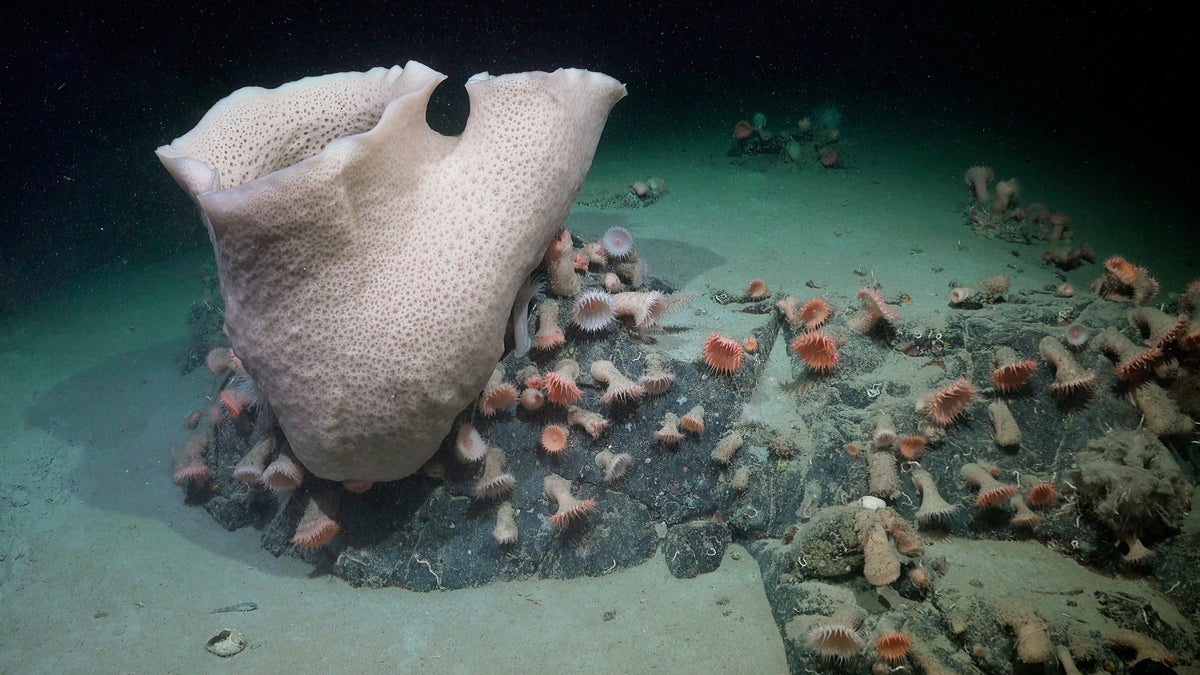Stunning Antarctic Sea Creatures Discovered after Iceberg Breaks Away
A calving iceberg exposed a region that never before had been seen by human eyes, revealing a vibrant, thriving ecosystem
A large sponge, a cluster of anemones, and other life is seen nearly 230 meters deep at an area of the seabed that was very recently covered by the George VI Ice Shelf in Antarctica. Sponges can grow very slowly, sometimes less than two centimeters a year, so the size of this specimen suggests this community has been active for decades, perhaps even hundreds of years.
Join Our Community of Science Lovers!
In H. P. Lovecraft’s chilling science-fiction novella At the Mountains of Madness, a group of researchers uncovers the ruins of an ancient alien civilization while exploring beneath Antarctica. Now a real team has investigated what lies beneath some of the frozen continent’s floating ice, and its findings are certainly otherworldly.
Scientists onboard the Schmidt Ocean Institute’s research vessel Falkor (too) sailed to Antarctica to study the nearby seafloor, the creatures that live there and the way climate change is affecting Antarctic ice and the ecosystems that evolved around it. But their plan was sidetracked after an iceberg the size of Chicago broke away from a nearby ice shelf in Bellingshausen Sea on January 13.
The ice front left behind where the iceberg calved off in the Bellingshausen Sea.
If you’re enjoying this article, consider supporting our award-winning journalism by subscribing. By purchasing a subscription you are helping to ensure the future of impactful stories about the discoveries and ideas shaping our world today.
The researchers sent their underwater robot SuBastian into the deep and found an ecosystem filled with anemones that look like Dr. Seuss’s Truffula Trees, along with sea spiders, icefish, octopuses. Some of the creatures that are new species, and many may only be found near Antarctica. Beyond simply being remote, the continent has been isolated for millions of years by the Antarctic Circumpolar Current, which surrounds it like a moat around a castle.
An octopus rests on the seafloor 1150 meters deep in the Bellingshausen Sea.
The tentacles of a solitary hydroid drift in currents 360 meters deep at an area of the seabed that was very recently covered by the George VI Ice Shelf. Solitary hydroids are related to corals, jellyfish, and anemones, but do not form colonies.
“Because the Bellingshausen Sea is not much explored in terms of deep-sea biodiversity, we expect many new species from the expedition. And in fact, we have already confirmed some, including snails, polychaete worms, crustaceans and even fish,” says the expedition’s co-chief scientist Patricia Esquete of the Center for Environmental and Marine Studies and the University of Aveiro in Portugal.
The researchers also encountered large vaselike sponges whose size hints at their age. “Based on the size of the animals, the communities we observed have been there for decades, maybe even hundreds of years,” Esquete said in a recent press release.
A squid eats a fish at a depth of nearly 950 meters in the Bellingshausen Sea.
Patricia Esquete inspects a suspected new species of isopod that was sampled from the bottom of the Bellingshausen Sea. It will take scientists years to describe all of the new species found during this expedition.
Less certain is how this vibrant ecosystem will fare now that the iceberg has broken away. Many deep-sea dwellers are adapted to unchanging conditions found in their environment, so they are highly sensitive to even small environmental shifts. For the life-forms uncovered in Bellingshausen Sea, the dramatic loss of their former iceberg ceiling may rock their ecosystem.
Montelli says that the floating ice shelf that the iceberg broke away from has retreated inland by about 25 miles (40 km) over the past 50 years—just one example of accelerating ice loss on the continent. “The ice loss from the Antarctic Ice Sheet is a major contributor to sea level rise worldwide,” Montelli said in the recent press release. “Our work is critical for providing longer-term context of these recent changes, improving our ability to make projections of future change.”
Ashley Balzer Vigil writes about astrophysics for NASA’s Goddard Space Flight Center by day and moonlights as a freelance environmental writer.
Source: www.scientificamerican.com
